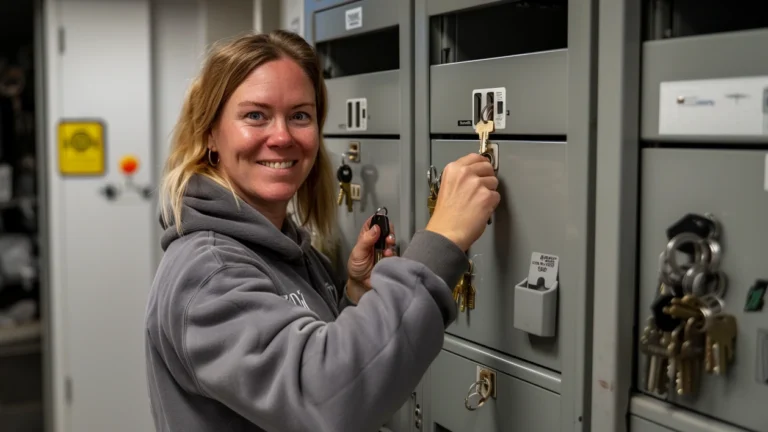In the world of business, servicing of assets is kind of an unsung hero, quietly ensuring the smooth operation and longevity of assets and equipment. After all, effective servicing strategies stand behind maximum productivity and costs effectivity, while at the same time ensuring employee safety.
But what exactly is servicing, how do we distinguish between the different types of servicing, and how can we enable the most cost-effective approach?
This guide will take you through the essentials, answering the question “what is servicing”. We will show you the different types of servicing and discuss the importance of well-trained staff, which stands behind solid servicing. As well as diving into the role of software in the optimization of all servicing processes.
List of contents
- Servicing is vital for the safety, efficiency, and longevity of all equipment.
- Regular servicing can contribute to accurate data collection, adequate task priority setting, increased productivity and cost reduction.
- Using tools to monitor equipment condition and proactive problem detection can help to minimize loss induced by downtime while ensuring optimal device performance.
What is servicing?
Servicing is about keeping the equipment in good working condition to ensure optimum performance, efficiency, and guarantee maximum safety. It covers a wide range of activities, such as Inspection, repair, and maintenance of equipment, assets, and buildings. The final goal being minimization or even complete avoidance of downtime.
Servicing is crucial in many industries, from manufacturing and healthcare to logistics and transportation.
Another sector in which servicing plays an indispensable role is facilities management. The value of facilities management is often recognized only when something goes wrong: the heating breaks down in the winter cold, the lighting in a commercial building doesn’t work or a water pipe bursts. It is the ability to identify problems before they occur and quickly react when they happen, which makes facility management an indispensable part of servicing.
The right servicing strategy allows companies to increase lifespan of their assets, optimizing their performance, preventing unplanned downtime and reducing cost expenditure.
The importance of regular servicing measures

Routine servicing is vital for the longevity, efficiency, and safety of equipment. It consists of activities such as routine inspections, cleaning and lubrication, which help to avoid unexpected breakdowns and costly repairs.
In technical facilities management, regular servicing measures for systems such as air conditioning, heating, and lighting ensure that the whole building functions smoothly, while guaranteeing a pleasant working environment.
Using specialized software can improve the planning of servicing processes, making them more organized and efficient. Some advantages of using Wowflow are:
- Reliable data acquisition about faults and failures
- Automation of servicing tasks
- Delegation of work assignments and responsibilities
- Maintenance planning
See the benefits of our servicing software for yourself. Create a free account here.
What is the difference between maintenance and servicing?
Maintenance and servicing are two terms that are often used interchangeably, but in fact, they describe different aspects of dealing with technical systems. Maintenance is more preventive and focused on avoiding problems, whereas servicing is a more comprehensive approach that also includes reactive measures of problem-solving.
A good balance between maintenance and servicing is important to ensure cost efficiency, high performance and equipment reliability, as it promotes effective resource allocation and early detection of possible equipment failures.
This guide will tell you everything you need to know about the relevance of professional maintenance for your building and its systems.
- Professional maintenance plan templates for maximum productivity in your building.
The impact of poor servicing on performance and safety
Inadequate maintenance can have serious consequences for performance and safety. Poor maintenance can result in:
- A higher frequency of failures
- Reduced performance and service lifespan of assets
- Reduced efficiency of equipment
- System outages
- Risks to the safety and health of the occupants and workers
Risks connected with delayed servicing
Late maintenance measures can result in various potential hazards, such as:
- Security risks
- Reduced productivity
- Interruptions to operations
- Increased repair and replacement costs
- Environmental hazards
- Damage to company reputation
To minimize potential hazards and ensure a safe working environment, it is important to take care of maintenance and servicing in a timely manner.
Different servicing types and strategies
There are different types of servicing strategies, each with their own advantages and applications, but they can be divided into two types.
Corrective servicing involves repairing or replacing components when a failure has occurred or is imminent, while preventive servicing focuses on proactively identifying and repairing components to avoid potential failures in the future.
Predictive servicing techniques, on the other hand, implement data reports to identify potential problems and enable timely servicing activities. Another approach is condition-based servicing, in which maintenance activities are tailored to the current condition of the equipment.
We will examine each of these servicing types and their benefits in more detail.
Preventive servicing: proactive care
Preventive servicing involves proactively servicing equipment to avoid breakdowns. This includes, for example, oil changes, transmission maintenance and component inspection based on operating time.
These measures are taken to address potential problems before they turn into costly failures.
The benefits of preventive servicing include:
- Improving equipment efficiency
- Reduction of energy consumption
- Downtimes minimization
- Extending the service lifecycle of equipment
- Reducing the need for major repairs
By proactively addressing potential issues, companies can benefit from preventive servicing and achieve cost savings in the long run.
With a calendar function for intuitive task planning, Wowflow offers you an easy way to plan your servicing proactively. Get started with Wowflow now.
Corrective servicing: Reactive solutions
In contrast to the preventive strategy, corrective servicing aims to repair or replace components after a fault has occurred or is about to occur.
This reactive approach is often more expensive than planned servicing, as it is only carried out after a failure has occurred. Nevertheless, it can be an essential part of your overall servicing strategy, especially in the event of unexpected breakdowns that require immediate attention.
The key to minimizing the financial impact of corrective servicing is to prioritize other maintenance techniques, such as:
- Monitoring critical systems condition
- Regular inspections
- Implementing a predictive servicing program
- Training and further education of servicing personnel about best practices
- Use of technology and asset management software
By proactively monitoring equipment condition and identifying potential problems before they lead to failure, companies can reduce the need for unplanned maintenance and minimize costs associated with a reactive approach.
Predictive servicing techniques: Data-driven decisions
Predictive servicing is a data-driven servicing planning methodology that uses technology and analytics to predict potential equipment failures by monitoring parameters such as:
- Temperature
- Vibration
- Pressure
- Performance indicators
Companies can recognize early signs of potential failures or anomalies in real-time, and plan servicing activities accordingly. This proactive approach can help minimize downtime, reduce costs and improve overall equipment reliability.
Condition-based servicing: intelligent servicing management in action
Condition-based servicing adapts the maintenance activities to the current equipment condition and only carries out an action if one or more indicators suggest that the equipment is likely to fail, or its performance is declining.
This approach offers companies the following advantages:
- Improving system availability and performance: by detecting and correcting defects in short time, downtime can be avoided, and operational efficiency can be increased.
- Cost reduction: As servicing measures are carried out, based on the actual system condition instead of predetermined time intervals, unnecessary work and material costs can be reduced.
- Extending the service life of systems: Early detection and treatment of wear and tear help to extend the service life of systems.
- Improved planning: Predictable, condition-based servicing enables better integration of servicing work into the operating process and minimizes disruptions in operation.
- Increased operational safety: Regular condition monitoring and diagnostics lead to increased operational safety.
Keeping an eye on finances: planning servicing measures
Cost-effective planning of servicing involves evaluating the benefits and costs of various servicing activities and aligning them with possible budget constraints to ensure optimal results.
By comparing costs with the value and repair history of individual devices, companies can make data-driven decisions about the cost-effectiveness of repairs and set the priorities of servicing tasks accordingly.
In addition to this, by regularly assessing fleet performance and making data-driven decisions about replacing or upgrading equipment, companies can align their budget to their servicing needs.
Cost-efficient planning of servicing tasks
To develop a cost-effective servicing strategy, you need to weigh up the costs and benefits of different servicing types presented above and choose the most appropriate approach for your company.
For example, switching from reactive servicing (fixing problems as they occur) to predictive servicing can significantly reduce the cost of emergency repairs and unplanned downtime.
The use of digital solutions, Computerized Maintenance Management Systems (CMMS), can also streamline the planning and scheduling of servicing work, while improving communication and optimizing resource utilization, which ultimately leads to cost reduction.
Wowflow’s software addresses the unique challenges of servicing, regardless of the size of your organization. Instead of the complexity of many available CMMS solutions, Wowflow strives for simplification. Our software helps you to complete tasks effortlessly, enabling teamwork, managing orders efficiently and monitoring your systems seamlessly.
Test the simple and cost-effective solution for your servicing with Wowflow.
To the CAFM alternative!
The foundation of servicing: training and empowering employees
Avoid costly errors and reduce downtime by equipping your employees with the necessary skills to identify and resolve problems immediately.
Continuous training is crucial for your employees to ensure that they are equipped with the necessary skills and knowledge to carry out servicing work professionally.
Empowering your employees leads to:
- Increased productivity
- Reduced downtimes
- Creative solutions and improved efficiency
The role of software for servicing management
Servicing software can significantly improve the efficiency and effectiveness of your business by automating tasks, providing an organized overview and promoting cost efficiency.
Quality servicing software should include features such as asset management, work order tracking, inventory management, real-time monitoring and reporting, predictive planning of servicing, history tracking and servicing logs, and spare parts management.
With Wowflow’s servicing software, you can design your processes efficiently to minimize downtimes. Create a free account now!
Successful servicing strategy implementation
The development and implementation of a successful servicing strategy includes:
- Understanding the current status of your servicing processes
- Evaluation and analysis of your current performance
- Using the right means and resources
- Automating work orders and inventory tracking
- Improving communication and data management
The following segment deals with strategies for assessing business needs and servicing objectives, as well as the integration of planned servicing into business operations.
Evaluation of company requirements and servicing goals
In order to align servicing activities with corporate goals, companies must first understand their goals and values. This includes:
- Definition of responsibilities linked to servicing activities, such as cost control and budgeting, procurement of important parts and materials
- Setting SMART goals
- Establishing a clear hierarchy and channels of communication
By weighing up the servicing costs against the value of repair, based on the individual devices maintenance history, companies can make educated decisions about the cost-effectiveness of repairs and prioritize servicing tasks accordingly.
Integration of scheduled servicing into business operations
Integrating planned servicing into business operations is important in order to minimize downtime and reduce the impact on productivity as much as possible. To achieve this, companies can use the following strategies:
- Joint planning and scheduling
- Set tasks and projects priorities
- Choose an accountable project manager
- Include all relevant interest groups
- Create an asset register for tracking progress
By following these strategies, companies can effectively integrate a maintenance plan, which would include scheduled servicing into their operations.
Summary
Well-planned and executed servicing is essential for the longevity, efficiency, and safety of appliances, systems, and buildings. By understanding the different types of servicing, implementing cost-effective planning, empowering your staff and using software for servicing management alongside with condition monitoring tools, companies can optimize their servicing processes and minimize downtime.
The key to success lies in aligning servicing activities with the company’s objectives and continuously evaluating and adapting their strategy to meet the constantly evolving company requirements.
Frequently asked questions
What is the difference between repair and servicing?
Although both repair and maintenance involve the servicing of equipment, their objectives and approaches are different. Repair is used to correct unforeseen malfunctions, while servicing is used to prevent them.
Repairs often involve fixing mechanical problems, replacing faulty components and rectifying software problems.
What are the 4 servicing measures?
The four main servicing measures are maintenance, inspection, repair, and improvement.
Maintenance refers to regular, preventive measures to maintain equipment or assets in a good operating condition.
Inspection involves checking the functionality and condition of a system in order to identify possible defects.
Repair is the elimination of defects discovered during the inspection. And improvement consists of adapting or modifying the system to increase its performance or to respond to technological advancements.









